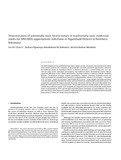Please use this identifier to cite or link to this item:
http://hdl.handle.net/10311/1361| Title: | Determination of potentially toxic heavy metals in traditionally used medicinal plants for HIV/AIDS opportunistic infections in Ngamiland District in Northern Botswana |
| Authors: | Ngwenya, Barbara Raletamo, Keleabetswe M. Marobela, Kerstin Andrae |
| Keywords: | Traditional medicinal plants arsenic chromium lead nickel AAS |
| Issue Date: | 8-Dec-2011 |
| Publisher: | Elsevier, www.elsevier.com/locate/aca |
| Citation: | Okatch, H. et al (2011) Determination of potentially toxic heavy metals in traditionally used medicinal plants for HIV/AIDS opportunistic infections in Ngamiland District in Northern Botswana, Analytica Chimica Acta, Vol. 730, pp.42-48 |
| Abstract: | The determination of four potentially toxic heavy metals, arsenic, chromium, lead and nickel in twelve plant species used for the treatment of perceived HIV and AIDS-associated opportunistic infections by traditional healers in Ngamiland District in Northern Botswana, a metal mining area, was carried out using atomic absorption spectrometry. The medicinal plants; Dichrostachys cinerea, Maerua angolensis, Mimusops zeyheri, Albizia anthelmintica, Plumbago zeylanica, Combretum imberbe, Indigofera flavicans, Clerodendrum ternatum, Solanum panduriforme, Capparis tomentosa, Terminalia sericea and Maytenus senegalensis contained heavy metals in varying quantities: arsenic 0.19–0.54 g g−1, chromium 0.15–1.27 g g−1, lead 0.12–0.23 g g−1 and nickel 0.09–0.21 g g−1 of dry weight. Chromium was found to be the most abundant followed by arsenic and lead. Nickel was undetectable in nine plant species. M. senegalensis contained the largest amounts of arsenic, chromium and lead. All metals determined were below the WHO permissive maximum levels. The possible maximum weekly intakes of the heavy metals following treatment regimes were insignificant compared to the provisional tolerable weekly intake levels recommended by WHO and the Joint FAO/WHO Expert Committee on Food Additives. This suggests that heavy metal exposure to patients originating from consumption of traditional medicinal plant preparations is within non health-compromising limits. |
| URI: | http://hdl.handle.net/10311/1361 |
| ISSN: | 0003-2670 (Print) 1873-4324 (Online) |
| Appears in Collections: | Research articles (ORI) |
Files in This Item:
| File | Description | Size | Format | |
|---|---|---|---|---|
| Okatch et.al _ 2011 _ELS.pdf | 249.92 kB | Adobe PDF |  View/Open |
Items in DSpace are protected by copyright, with all rights reserved, unless otherwise indicated.
